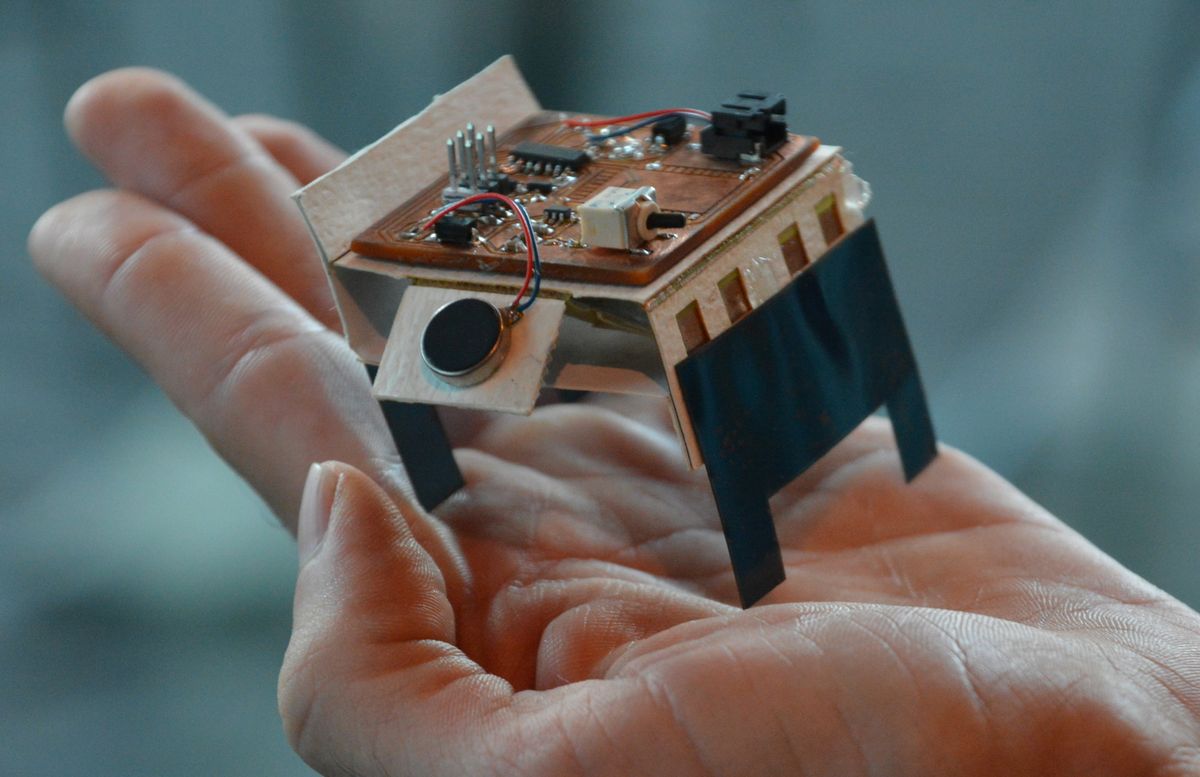Robot swarms generally come in two flavors. You’ve got your homogenous swarms, made up of tens or hundreds or sometimes thousands of identical robots. You’ve also got your heterogenous swarms, made up of a handful (or possibly a few tens) of robots that aren’t all identical, and may in fact be significantly different. Heterogeneity is appealing, because robots are bad multitaskers, and with a heterogenous swarm you can deploy a bunch of specialists instead. Problem is, designing, constructing, and then deploying a bunch of specialists is way harder than when you’re only dealing with one type of generalist robot, which is why we don’t see large heterogeneous swarms.
Researchers at the University of California, San Diego, are taking the first steps toward robotics swarms that can be rapidly customized, self-assembled, and then self-deployed, without needing tedious human intervention at every step of the way. They’re laser-cut from flat sheets, can fold themselves up, and then skitter away with only a minimum of human finger-lifting.
The heterogeneous swarm idea is not a new one: Insects have been doing it for ages, and it’s been very effective for them. With ants, for example, you’ve got little workers and some big soldiers, neither of which are suited for doing each other’s jobs, but together, they make the overall swarm much more efficient. Sadly, we’re not as clever as the ants at autonomously generating new swarm members, but Michael Tolley’s lab at UCSD has been making progress in the right direction.
We’ve covered some of Tolley’s work before, in the context of self-folding mobile robots. In a recent paper from IROS, one of his students, William Weston-Dawkes, along with Aaron Ong, Ramzi Majid, and Francis Joseph, presented some new work on making a more reliable type of laser-machined self-folding robot that has the potential to be easily customized for speed, maneuverability, and payload:
These robots are, essentially, bristlebots: They use vibration motors to shimmy themselves along on flat surfaces. Despite their simplicity, they can move at up to 23 centimeters per second in a straight line, which is quite fast for their size. The motion characteristics of these robots can be tweaked by adjusting the length of their legs, which makes them a useful platform to experiment with design changes, especially since leg length adjustment is easily automated as part of the design and construction process.

The structure of these robots is primarily composite laminates: paperboard and spring steel for strength, kapton for flexibility, a pre-strained polystyrene shape-memory material to control the self-folding process, plus an adhesive to bind all the layers once they’ve been laser cut into shape.
The electronics do take a little bit of extra work; the components are soldered on by hand, but that’s something that wouldn’t be too difficult to automate either. Once everything is sandwiched together, an embedded heating circuit activates the shape-memory material to fold the flat sheets into a four-bar parallelogram linkage that makes sure the robot’s legs always end up at the same angle. The heating circuit draws much more power than the robot does while it’s in motion, so it’s attached to off-board power and hot-glued to the robot, disconnecting when the folding process is complete.
This is really just the beginning for this research—as the title of the IROS paper says, they’re working “Towards Rapid Mechanical Customization of cm-scale Self-Folding Agents,” but they’re not there yet. Next steps include changing the structure of the robot (beyond just the legs) to see what kinds of advantages and disadvantages such changes could lend to a heterogenous swarm, as well as working toward having more than one of these things zipping around at the same time, as the researchers explain:
Future work will investigate how the robot structure can be tailored to a given payload or environment. For example, by increasing or decreasing the mass of the system, the resonant frequency will shift resulting in a change of peak locomotion speed. Parameters such as leg length and material can be used to keep the resonant frequency within the operating range of the motors.
Additional work includes further developing the capability to deploy several self-folding laminate robots simultaneously and have them complete a coverage or search task with onboard sensing. We plan to investigate different wireless communication modalities, localization algorithms, and swarm control techniques as steps towards this goal.
It’s not quite a swarm yet, but it’s a start.
“Towards Rapid Mechanical Customization of cm-scale Self-Folding Agents,” by William P. Weston-Dawkes, Aaron C. Ong, Mohamad Ramzi Abdul Majit, Francis Joseph, and Michael T. Tolley from the University of California at San Diego, was presented at IROS 2017 in Vancouver, Canada.
Evan Ackerman is a senior editor at IEEE Spectrum. Since 2007, he has written over 6,000 articles on robotics and technology. He has a degree in Martian geology and is excellent at playing bagpipes.



